The Tricolored Heron hunted in the lake at the edge of our back yard,...
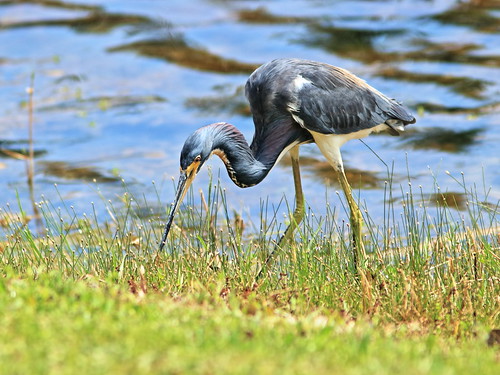
...stalking a fish...
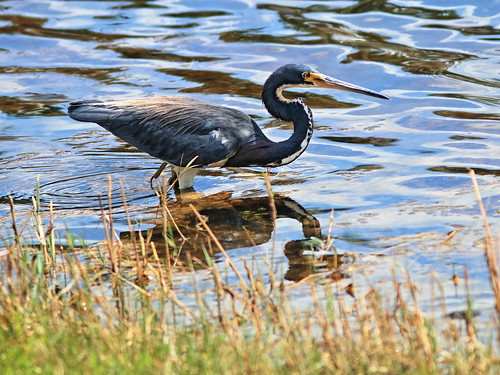
,,,and striking. Look closely and you may see that it caught two small fish in a single thrust:
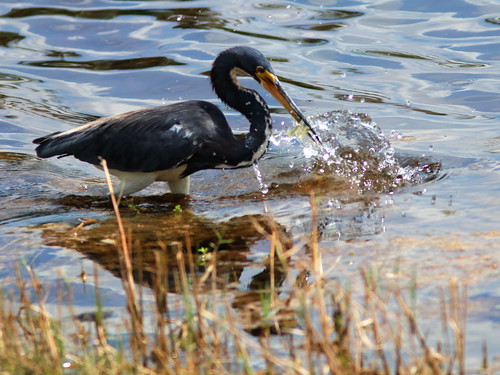
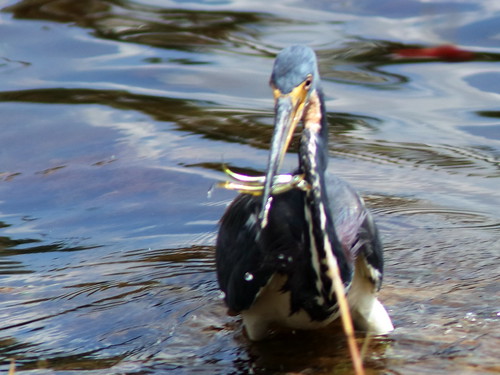
Somehow, the heron managed to maneuver the two little wiggling creatures up the length of its bill and finally swallow them. Of course, the Atlantic Puffin does even better than this. It has backward-pointing spines on its upper palate to hold dozens of little fish which are pushed up by its specialized bristly tongue and stored there while it catches even more. (Ref: LINK). I wonder if the heron used its tongue to help in the process:
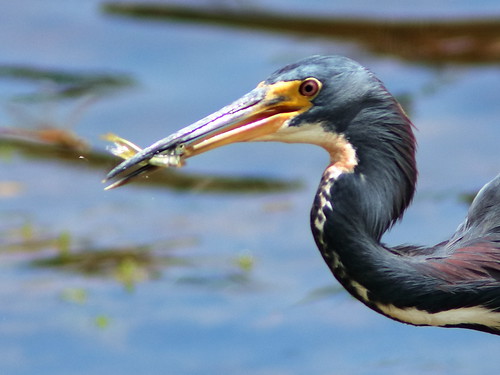
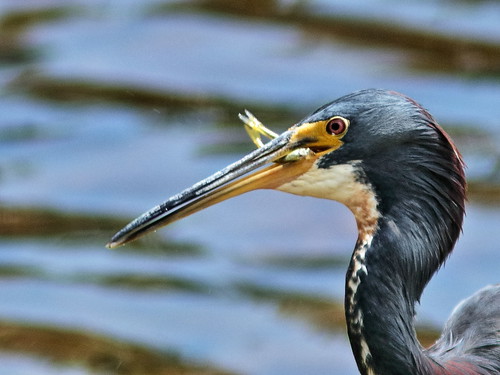

During the last part of July, the pre-dawn sky was dark except for the red planet Mars, as the Moon had been setting during the night, before we ventured out. The July full Moon is traditionally known as the "Buck Moon," because this is the time of year when the antlers of deer are undergoing rapid growth.
On July 27, the Earth passed directly between the Sun and the Moon, creating a total lunar eclipse which lasted nearly four hours. It was the longest of the 21st century. Unfortunately it was not visible here in south Florida. The eclipse did not commence until 3:30 PM our time, as it was rising the next morning over Africa, Europe, Australia, and Asia. The Moon turns blood-red during an eclipse because the Earth's atmosphere scatters the light, just as it does at sunrise and sunset.
This was the nearly-full Buck Moon setting below the western horizon, about a half hour before sunrise, as we walked out into the Wounded Wetlands at 6:20 AM on July 27. Its red color is not related to the impending eclipse, but is enhanced by the dust which has blown across the Atlantic Ocean from the Sahara Desert:
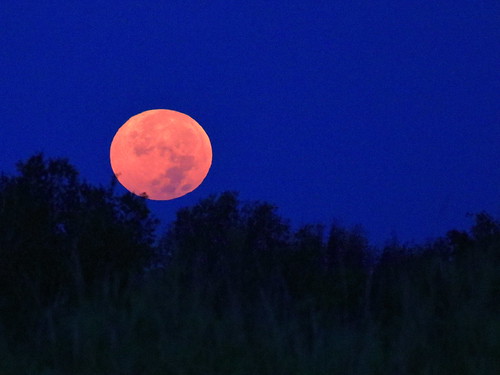
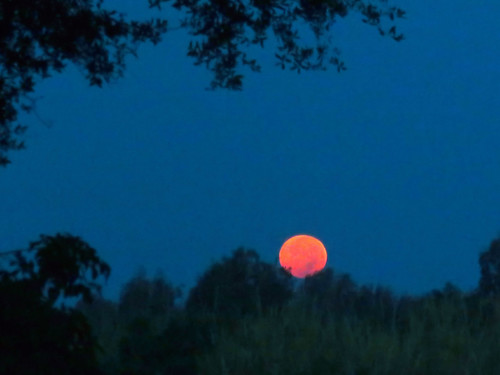
We had hoped to see the Moon set over the lake the next morning, but there were storms which kept us home until July 29, when it still looked almost full against the dark sky:
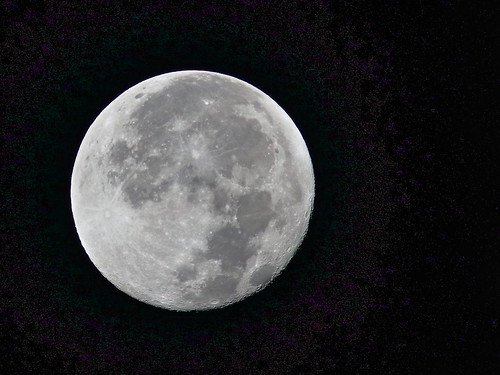
The Moon rode high in the brightening sky and served as the backdrop for a Loggerhead Shrike perched atop a Red Maple:
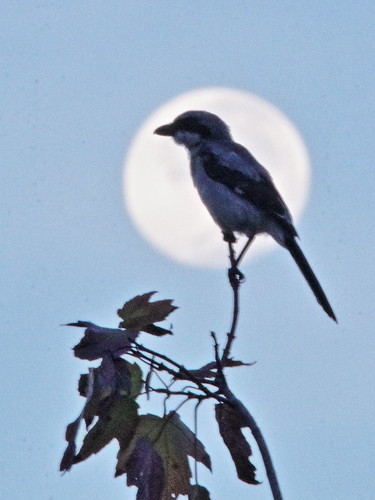
The same shrike appears in this photo:

Rain again threatened, but the Buck Moon briefly peeked through the clouds over the lake before disappearing:
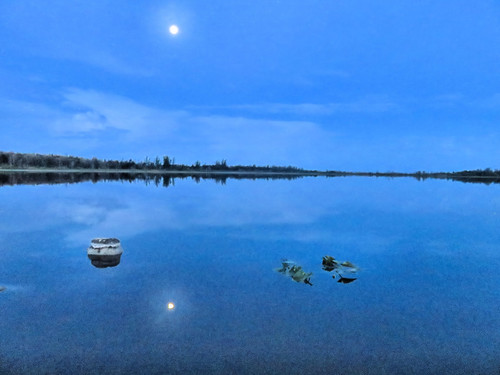
As if on cue to celebrate the Buck Moon, a yearling male White-tailed Deer pranced towards me in the low light. The wind was at his back, so the spike-buck did not catch my scent. At first he may have mistaken me for another deer and cautiously moved closer before he recognized me and bounded off:
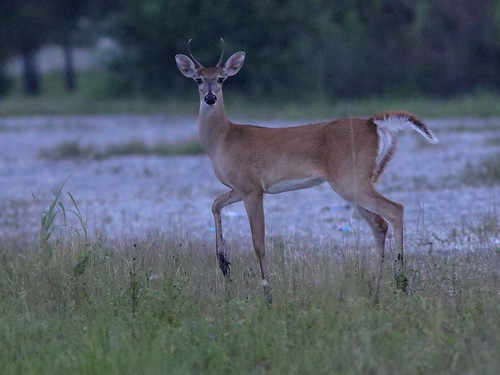
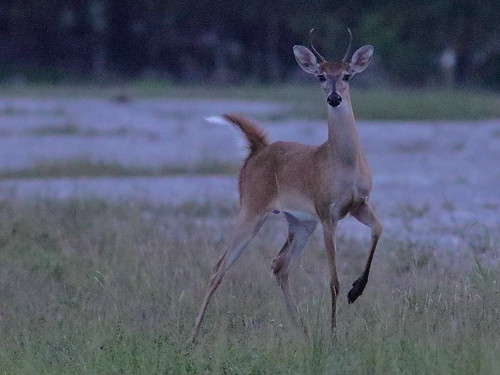
Twice more this past week, I got much better views of the spike buck Again, he approached quite closely before fleeing, leading me to wonder whether he was being fed by someone in the adjoining residential area :
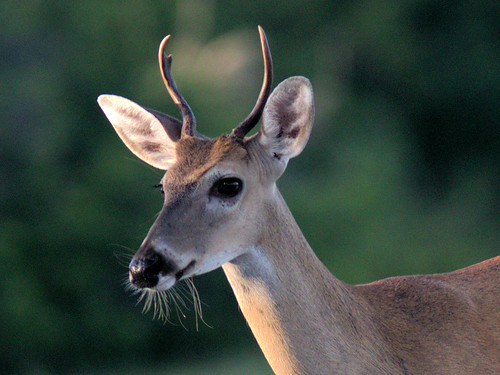
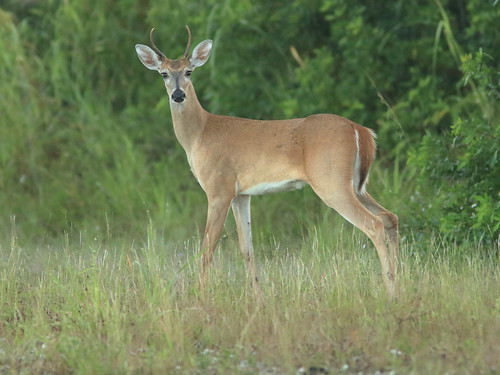
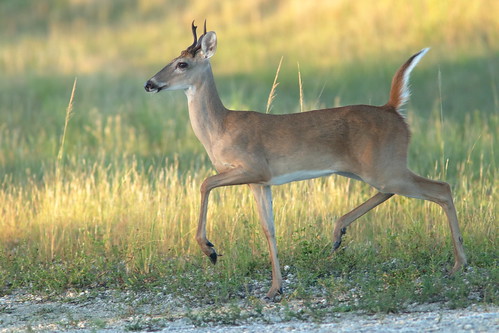
On the last day of July, a Louisiana Waterthrush arrived, the first sign that fall migration was now underway:
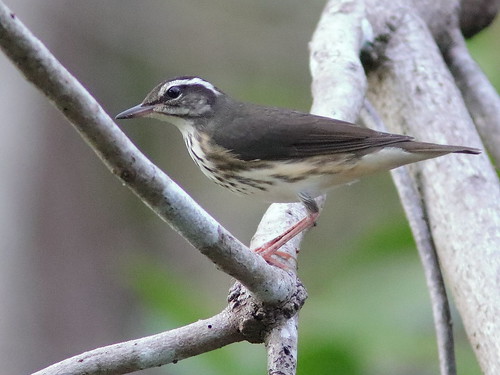
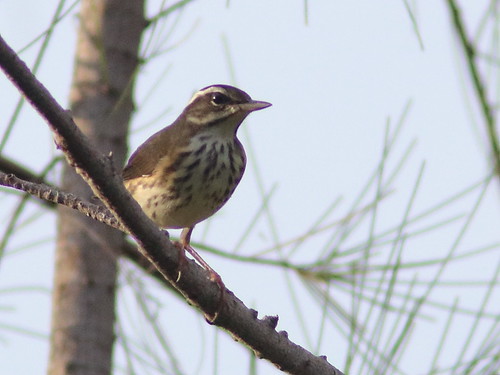
A Black-and-White Warbler was nearby, the first I had seen since last April:
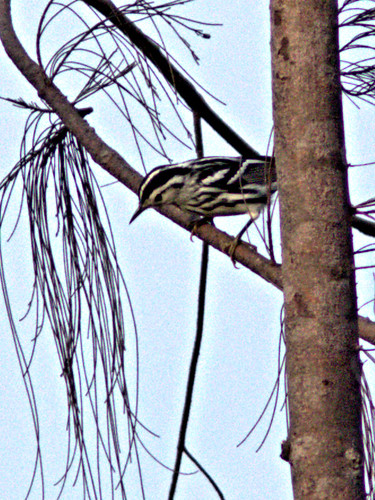
The next day I saw two Prairie Warblers, first of the season at this location.
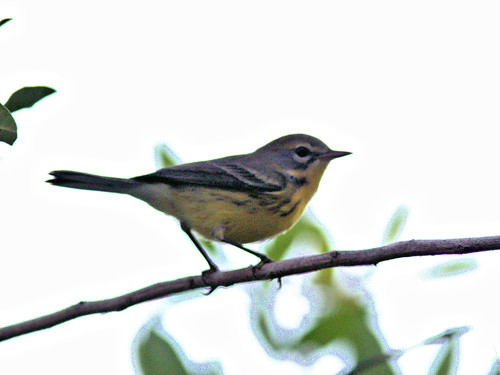
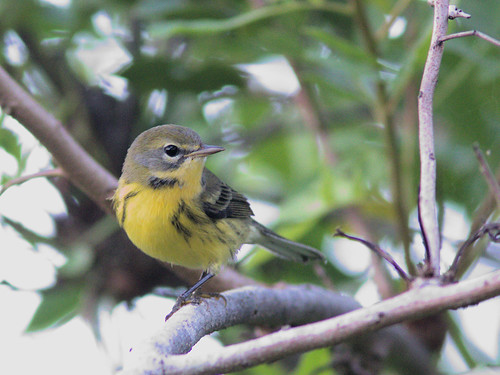
Prairie Warblers breed in southeasterm Florida but practically disappear from inland areas during May and June, as they nest mostly in mangroves along the Atlantic Coast at that time. They may also undergo their post-breeding molt, when many birds become reclusive. Feather replacement is very energy-intensive and they may migrate to favorable habitat where food is more abundant. Migrants from the north greatly increase their numbers during the winter season.
= = = = = = = = = = = = = = =
Linking to Misty's CAMERA CRITTERS,
Linking to Eileen's SATURDAY'S CRITTERS,
Linking to SKYWATCH FRIDAY by Yogi, Sylvia and Sandy
Linking to WEEKEND REFLECTIONS by James
Linking to BirdD'Pot by Anni
Linking to Our World Tuesday by Lady Fi
Linking to Wild Bird Wednesday by Stewart
Linking to Wordless Wednesday (on Tuesday) by NC Sue
Linking to ALL SEASONS by Jesh
________________________________________________
Please visit the links to all these memes to see some excellent photos on display
________________________________________________
Many wonderful shots. Love your critters
ReplyDeleteWhat a wonderful variety!
ReplyDeleteA very nice series, Ken! Love the moon shots and that young buck is special. I'm jealous you've already seen a couple of likely migrants!
ReplyDeleteThat Tricolored Heron photograph was great! Wish I could catch two at a time.
Lovely set of photos, clever heron and I do like that Prairie Warbler. As for the red moon it was the only night in weeks that we had a full cloud cover but sadly no rain which is sorely needed. Enjoy your weekend Diane
ReplyDeleteWonderfully sharp photos of the heron. Sometimes i think the heron's here are going to starve to death. They stand for hours and don't catch anything.
ReplyDeleteBeautiful pics of the Buck Moon. We of course had a buck moon but I couldn't see if before it was pretty high in the sky and I saw no traces of red.
Great photos of the birds!!
You are talented and skillful photographer!!
As always your photographs are lovely but the red moon is other wordly!
ReplyDeletefantastic nature
ReplyDeleteBeautiful moon shots. Love the capture of the shrike against the moon!!
ReplyDeleteMarvellous.
ReplyDeleteWow -- spectacular shots of that pink moon and the heron!
ReplyDeleteWow! Wow! Wow! What more can I say? These photos are all fantastic.
ReplyDeleteStunning ohtos kenneth as usual but my favourite is the close up of the Deer. Have a lovely weekend.
ReplyDeleteYou got some sensational shots of the moon there!
ReplyDeleteHello, the Tricolored Heron is gorgeous. I love your beautiful moon photos. Neat shot of the Shrike. Great captures of the deer! Thank you for linking up and sharing your post. Happy Saturday, enjoy your weekend. PS, thanks also for the comment on my post.
ReplyDeleteBeautiful birds!
ReplyDeleteLove the spike buck photos!
The Heron is amazing!
Have a great weekend!
The two fish catch is pretty amazing and then to capture it is great! Love all the sweet Warblers here in Florida and your moon photos. Enjoy your weekend!
ReplyDeleteEnjoyed all your photos in this post especially the ones of the yearling buck!
ReplyDeleteLove the shrike in the moon glow! And, watching the heron with his catch of the day! I don't recall ever spotting a prairie warbler...nice!!
ReplyDeleteAs always, thanks for linking in at I'd Rather B Birdin'
Loved the Tri-color heron and those beautiful moon shots! The little deer is adorable!
ReplyDeleteYou're a wonderful storyteller with your words and photos. Thanks for the story of the heron and his catch. :-)
ReplyDeleteWhat a catch for the heron, and for you catching his moment, as well as of the deer - awesome! Since you know the word Schneiderlein, I wonder if you have a German heritage? (your last name is also Germain) Many thanks for sharing your captures with All Seasons, and have a great week! (writing from my other blog - Jesh)
ReplyDeleteTremendous photos especially the heron with its catch.
ReplyDeleteI've never heard of a Buck Moon - thanks for the info. I love the shot of the buck with the whiskers highlighted … precious! I am not surprised to read that you are starting to see birds arrive from migration. When we returned from our 3-week vacation, many of the birds we had been seeing have disappeared … for them, fall is on the way!
ReplyDeleteIn reply to Junieper (Jesh)-- Yes, my paternal grandfather was a first generation from Germany. When he was growing up he would be punished if his father caught him speaking German with his friends, probably because Germans were viewed with suspicion during the build-up to the First World War. I remembered the story from early childhood because that is when I learned the English meaning of my name. My Dad was great at reading to me-- especially Thornton Burgess nature stories, and he often added his own footnotes. I loved these encounters so much that I wanted him to read to me even though I was able to read on my own.
ReplyDeleteGreat shots - I love the one of the buck with his tail held high - made me think of the word 'prancing'.
ReplyDeleteCheers - Stewart M - Melbourne
Wonderful photos! I am impressed by the shrike with the moon. Wow!
ReplyDeleteLovely pictures of birds and wildlife.
ReplyDelete